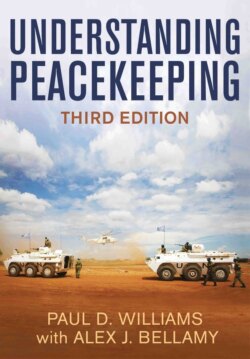Читать книгу Understanding Peacekeeping - Alex J. Bellamy - Страница 38
Box 2.2 Assembling a United Nations peacekeeping operation
ОглавлениеThe UN has no army. Each peace operation must be designed to meet the requirements of each new situation; every time the Security Council calls for the creation of a new operation, its components must be assembled ‘from scratch’.
Following a Technical Assessment Mission to the region concerned carried out by a team from the UN Secretariat, the Secretary-General usually presents several options and recommendations to the Council on how the operation should be designed. After considering the Secretary-General’s recommendations, the Council authorizes the mission and determines its capabilities and mandate. Security Council votes are also subsequently required to change the mandate or strength of an existing mission. The mission’s budget is set by the General Assembly’s Fifth Committee.
Once established, the Secretary-General selects a Special Representative to lead the mission and asks member states to contribute troops, police or other civilian personnel. Supplies, equipment, transportation and logistical support must also be secured from member states or procured from private contractors. Civilian support staff include personnel assigned from within the UN system, loaned by member states and individuals recruited internationally or locally to fill specific jobs. Once deployed, the Department of Peace Operations (DPO) is responsible for overseeing the management and support of the mission.
Senior military officers, staff officers, military observers and individual police officers serving on UN peace operations are usually on secondment from their national security forces. Peacekeeping troops and formed police units – the blue helmets – participate in missions under terms negotiated between their governments and the UN and set out in a memorandum of understanding. They remain under the overall authority of their government while serving under UN operational command.
The lead-time required to deploy a mission varies and depends primarily upon the will of member states to contribute personnel and equipment. The timely availability of financial resources and strategic lift capacity also affect the time necessary for deployment. In 1973, for example, elements of the second UN Emergency Force (UNEF II) were deployed in the Middle East within twenty-four hours. However, for most missions it takes months to assemble and deploy the necessary elements.
Source: Adapted from United Nations, www.un.org/Depts/dpko/dpko/faq. (no longer operational); see also https://peacekeeping.un.org/en/forming-new-operation.
